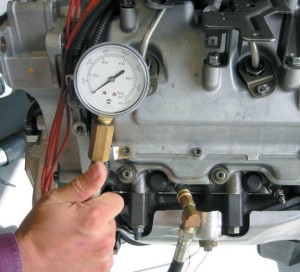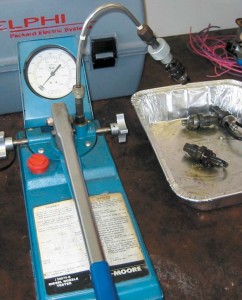Diesel engines can be diagnosed using a scan tool in most cases, because most of the pressure sensors values can be displayed. Common faults include:
- Hard starting
- No start
- Extended cranking before starting
Compression Testing
A compression test is fundamental for determining the mechanical condition of a diesel engine. Worn piston rings can cause low power and excessive exhaust smoke. To test the compression on a diesel engine, the following will have to be done.
- Remove the glow plug (if equipped) or the injector.
- Use a diesel compression gauge, as the compression is too high to use a gasoline engine compression gauge.
A diesel engine should produce at least 300 PSI (2,068 kPa) of compression pressure and all cylinders should be within 50 PSI (345 kPa) of each other.
Glow Plug Resistance Balance Test
Glow plugs increase in resistance as their temperature increases. All glow plugs should have about the same resistance when checked with an ohmmeter. A similar test of the resistance of the glow plugs can be used to detect a weak cylinder. This test is particularly helpful on a diesel engine that is not computer controlled. To test for even cylinder balance using glow plug resistance, perform the following on a warm engine.
- Unplug, measure, and record the resistance of all glow plugs.
- With the wires still removed from the glow plugs, start the engine.
- Allow the engine to run for several minutes to allow the combustion inside the cylinder to warm the glow plugs.
- Measure the plugs and record the resistance of all glow plugs.
- The resistance of all glow plugs should be higher than at the beginning of the test. A glow plug that is in a cylinder that is not firing correctly will not increase in resistance as much as the others.
- Another test is to measure exhaust manifold temperature at each exhaust port using an infrared thermometer or a pyrometer. Misfiring cylinders will run cold.
Injector Pop Testing
A pop tester is a device used for checking a diesel injector nozzle for proper spray pattern. The handle is depressed and pop-off pressure is displayed on the gauge.
The spray pattern should be a hollow cone, but will vary depending on design. The nozzle should also be tested for leakage (dripping of the nozzle) while under pressure. If the spray pattern is not correct, then cleaning, repairing, or replacing the injector nozzle may be necessary.
Next Steps towards ASE Certification
Now that you’re familiar with Compression Testing, Glow Plug Resistance Balance, and Injector Pop Testing, try out our free Automotive Service Excellence Tests to see how much you know!
![ASE Certification Training HQ - Free ASE Practice Tests [Updated 2021]](https://asecertificationtraining.com/wp-content/themes/simplefolio/images/ASE Certification Logo.png)


